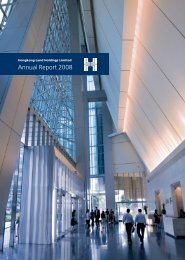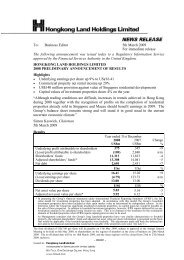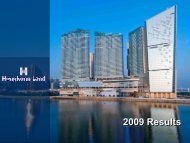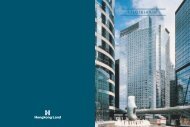Annual Report 2011 - Hongkong Land
Annual Report 2011 - Hongkong Land
Annual Report 2011 - Hongkong Land
Create successful ePaper yourself
Turn your PDF publications into a flip-book with our unique Google optimized e-Paper software.
2 Financial Risk Management continued<br />
Financial risk factors continued<br />
i) Market risk continued<br />
Interest rate risk<br />
The Group is exposed to interest rate risk through the impact of rate changes on interest bearing liabilities and assets. These<br />
exposures are managed partly by using natural hedges that arise from offsetting interest rate sensitive assets and liabilities,<br />
and partly through the use of derivative financial instruments such as interest rate swaps. The Group monitors interest rate<br />
exposure on a monthly basis by currency and business unit, taking into consideration proposed financing and hedging<br />
arrangements. The Group’s guideline is to maintain 40% to 60% of its gross borrowings in fixed rate instruments with an<br />
average tenor of two to three years. At 31st December <strong>2011</strong>, the Group’s interest rate hedge was 52% (2010: 62%) with<br />
an average tenor of nine years (2010: six years). The interest rate profile of the Group’s borrowings after taking into account<br />
hedging transactions are set out in Note 21.<br />
Cash flow interest rate risk is the risk that changes in market interest rates will impact cash flows arising from variable rate<br />
financial instruments. Borrowings at floating rates therefore expose the Group to cash flow interest rate risk. The Group<br />
manages this risk by using forward rate agreements to a maturity of one year, and by entering into interest rate swaps for<br />
a maturity of up to five years. Forward rate agreements and interest rate swaps have the economic effect of converting<br />
borrowings from floating rate to fixed rate.<br />
Fair value interest rate risk is the risk that the value of a financial asset or liability and derivative financial instrument will<br />
fluctuate because of changes in market interest rates. The Group manages its fair value interest rate risk by entering into<br />
interest rate swaps which have the economic effect of converting borrowings from fixed rate to floating rate.<br />
At 31st December <strong>2011</strong>, if interest rates had been 100 basis points higher/lower with all other variables held constant,<br />
the Group’s profit after tax would have been US$5 million (2010: US$7 million) higher/lower, and hedging reserve would<br />
have been US$54 million (2010: US$45 million) higher/lower as a result of fair value changes to cash flow hedges. The<br />
sensitivity analysis has been determined assuming that the change in interest rates had occurred at the balance sheet<br />
date and had been applied to the exposure to interest rate risk for both derivative and non-derivative financial instruments<br />
in existence at that date. The 100 basis point increase or decrease represents management’s assessment of a reasonably<br />
possible change in those interest rates which have the most impact on the Group, specifically the United States, Hong Kong<br />
and Singapore rates, over the period until the next annual balance sheet date. In the case of effective fair value hedges,<br />
changes in fair value of the hedged item caused by interest rate movements balance out in profit and loss account against<br />
changes in the fair value of the hedging instruments. Changes in market interest rates affect the interest income or expense<br />
of non-derivative variable-interest financial instruments, the interest payments of which are not designated as hedged items<br />
of cash flow hedges against interest rate risks. As a consequence, they are included in the calculation of profit after tax<br />
sensitivities. Changes in the market interest rate of financial instruments that were designated as hedging instruments in<br />
a cash flow hedge to hedge payment fluctuations resulting from interest rate movements affect the hedging reserves and<br />
are therefore taken into consideration in the equity-related sensitivity calculations.<br />
Price risk<br />
The Group is exposed to securities price risk because of listed investments which are available for sale and held by the Group<br />
at fair value. Gains and losses arising from changes in the fair value of available-for-sale investments are recognised in other<br />
comprehensive income. The performance of the Group’s listed and unlisted available-for-sale investments are monitored<br />
regularly, together with an assessment of their relevance to the Group’s long term strategic plans. Details of the Group’s<br />
available-for-sale investments are contained in Note 14.<br />
Available-for-sale investments are unhedged. At 31st December <strong>2011</strong>, if the price of listed and unlisted available-for-sale<br />
investments had been 25% higher/lower with all other variables held constant, total equity would have been US$12 million<br />
(2010: US$15 million) higher/lower. The sensitivity analysis has been determined based on a reasonable expectation of<br />
possible valuation volatility over the next twelve months.<br />
<strong>Annual</strong> <strong>Report</strong> <strong>2011</strong> 33
















